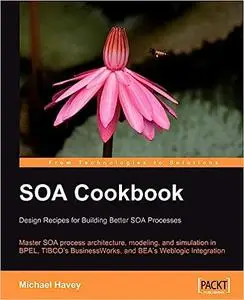Michael Havey, "SOA Cookbook: Master SOA process architecture, modeling, and simulation in BPEL, TIBCO's BusinessWorks, and BEA's Weblogic Integration"
English | 2008 | ISBN: 1847195482 | PDF | pages: 269 | 4.4 mb
English | 2008 | ISBN: 1847195482 | PDF | pages: 269 | 4.4 mb
In Detail
SOA Cookbook covers process-oriented SOA. BPEL is the best-known language in this area, and this book presents numerous BPEL examples. It also studies proprietary vendor process languages such as TIBCO's BusinessWorks and BEA's Weblogic Integration. If you are building SOA processes in the field, chances are you are using one of the languages discussed in SOA Cookbook. The book assumes that the reader is comfortable with XML and web services.
Author Michael Havey works with SOA in the field for TIBCO (and previously for IBM, BEA, and Chordiant). SOA Cookbook is Michael's second book. Essential Business Process Modeling, his first book, was published in 2005.
What you will learn from this book?
- Document a process-based SOA architecture using "enhanced 4+1", ARIS, SCA, UML, and BPMN
- Learn by example how to separate BPM and SOA processes
- Model choreography and orchestration in BPMN and BPEL
- Divide a process that involves both manual and automated activities between BPM and SOA
- Manage state in short- and long-running processes
- Model processes intelligently using three variants of a structured "flat form" approach: event-based, state-based, and flow-based
- Develop dynamic processes to manage the "change problem": problems that arise when you need to change the definition of a process that has live cases in production
- Simulate SOA processes using concepts from discrete event simulation and the Poisson process
- Measure the complexity of SOA processes
Approach
As a cookbook, this book can be regarded as a set of gourmet recipes for SOA. Each of the eight chapters that follow the introductory chapter covers an important concept in process-based SOA and teaches techniques to build solutions based on the concept. Working examples are developed in BPEL, TIBCO's BusinessWorks and BEA's Weblogic Integration.
Who this book is written for?
The book is intended for hands-on SOA architects, designers, and developers who want to learn techniques in process orchestration. Many of these readers use, or will soon start using, languages such as BPEL, TIBCO's BusinessWorks, or BEA's Weblogic Integration in their projects.
This intermediate-level book assumes that the reader is comfortable reading XML and knows the basic concepts of web services. The book presents several BPEL and BPMN examples, but it explains specific language constructs on the fly; the reader need not have background in these languages.



